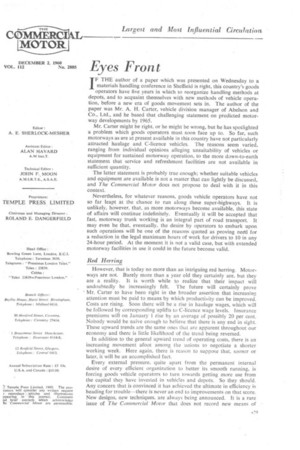Eyes Front
Page 31

Page 32

If you've noticed an error in this article please click here to report it so we can fix it.
IF THE author of a paper which was presented on Wednesday to a materials handling conference in Sheffield is right, this country's goods operators have five years in which to reorganize handling methods at depots, and to acquaint themselves with new methods of vehicle operation, before a new era of goods movement sets in. The author of the paper was Mr. A. H. Carter, vehicle division manager of Abelson and Co., Ltd., and he based that challenging statement on predicted motorway developments by 1965.
Mr. Carter might be right, or he might be wrong, but he has spotlighted a problem which goods operators must soon face up to. So far, such motorways as are at present available in this country have not particularly attracted haulage and C-licence vehicles. The reasons seem varied, ranging from individual opinions alleging unsuitability of vehicles or equipment for sustained motorway operation, to the more down-to-earth statement that service and refreshment facilities are not available in sufficient quantity.
The latter statement is probably true enough; whether suitable vehicles and equipment are available is not a matter that can lightly be discussed, and The Commercial Motor does not propose to deal with it in this context.
Nevertheless, for whatever reasons, goods vehicle operators have not so far leapt at the chance to run along these super-highways. It is unlikely, however, that, as more motorways become available, this state of affairs will continue indefinitely. Eventually it will be accepted that fast, motorway trunk working is an integral part of road transport. It may even be that, eventually, the desire by operators to embark upon such operations will be one of the reasons quoted as proving nee'd for a reduction in the legal maximum hours of work for drivers to 10 in any 24-hour period. At the moment it is not a valid case, but with extended motorway facilities in use it could in the future become valid.
Red Herring
However, that is today no more than an intriguing red herring. Motorways are not. Barely more than a year old they certainly are, but they are a reality. It is worth while to realize that their impact will undoubtedly be increasingly felt. The future will certainly prove Mr. Carter to have been right in the broader assertion that increasing attention must be paid to means by which productivity can be improved. Costs are rising. Soon there will be a rise in haulage wages, which will be followed by corresponding uplifts to C-licence wage levels. Insurance premiums will on January I rise by an average of possibly 20 per cent. Nobody would be naive enough to believe that there is any end in sight. These upward trends are the same ones that are apparent throughout our economy and there is little likelihood of the trend being reversed.
In addition to the general upward trend of operating costs, there is an increasing movement afoot among the unions to negotiate a shorter working week. Here again, there is reason to suppose that, sooner or later, it will be an accomplished fact.
Every external pressure, quite apart from the permanent internal desire of every efficient organization to better its smooth running, is forcing goods vehicle operators to turn towards getting more use from the capital they have invested in vehicles and depots. So they should. Any concern that is convinced it has achieved the ultimate in efficiency is heading for trouble—there is never an end to improvements on that score. New designs, new techniques. are always being announced. It is a rare issue of The Commercial Motor that does not record new means of
bettering vehicle utilization from some direction, whether in traffic or the engineering department.
Then, on top of all these strong reasons for ensuring that vehicles are on the road for the greatest possible time each day, there is this undeniable point made by Mr. Carter. Better roads and better vehicles are waiting in the foreseeable future. Operators must accept the ciaallenge, and realize that it does not invariably follow that today's techniques are tomorrow's answers. They may not be.
In any case, who would be brash enough to assert that he knows—and, more important, employs—all the latest techniques relevant to his particular traffic? Five years ago mechanical handling, palletization, use of containers, even the present widespread operation of semi-trailers, were, somewhat, novelties. And yet today they are comparatively commonplace, although to nothing like the extent that they should be.
Who, therefore, can categorically deny Mr. Carter's assertion? It would be more sensible to at least explore new avenues such as he suggests. One thing that can be stated positively is that the operator who looks to the future will be less likely to founder on the unseen rocks ahead.




















































































































